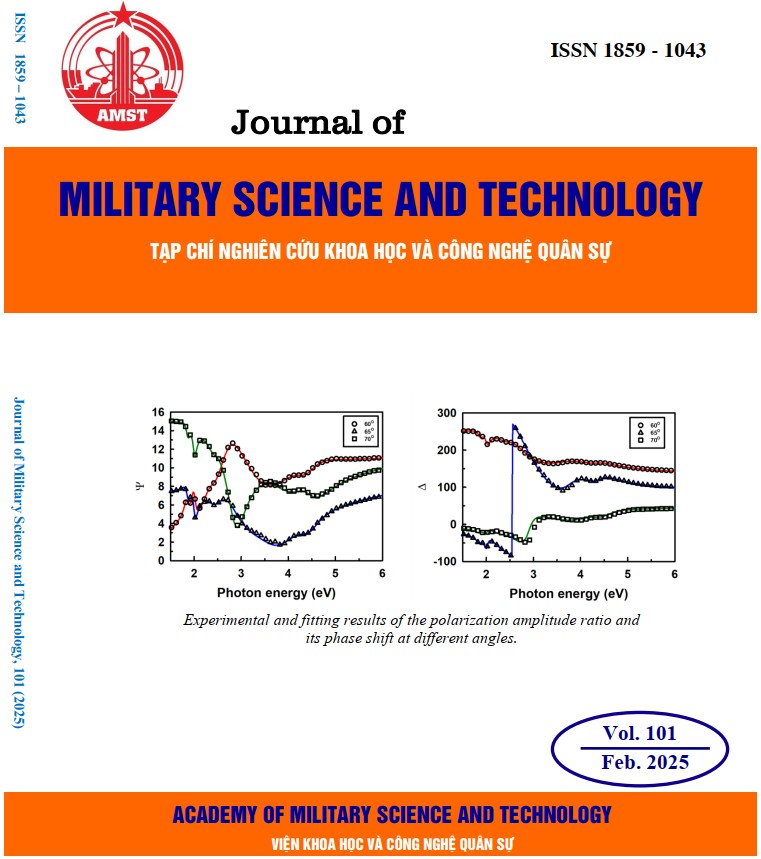Green synthesis of nano CeO2 using cleistocalyx operculatus leaf extract
366 viewsDOI:
https://doi.org/10.54939/1859-1043.j.mst.101.2025.95-101Keywords:
Green synthesis; CeO2 nanoparticles; Cleistocalyx operculatus; Polyphenol; Flavanol.Abstract
This study explores the green synthesis of CeO2 nanoparticles using an extract from Cleistocalyx operculatus leaves, a traditional medicinal plant known for its high antioxidant content. A detailed solvent optimization process identified ethanol-water (1:1) as the ideal medium for extracting the maximum amount of polyphenols and flavanols, essential for reducing and stabilizing nanoparticles. The morphology, structure, and physicochemical properties of the synthesized nanoparticles were analyzed using advanced techniques such as FE-SEM, EDX, XRD, FT-IR, UV-Vis, BET, and Zeta potential analysis. The CeO2 nanoparticles exhibited a fluorite cubic crystal structure with a crystal size of 12.04 nm, as determined by XRD. The nanoparticles demonstrated a high surface area (49.71 m²/g), stable zeta potential (-42 mV), and optical and functional properties characteristic of CeO2. These results underscore the potential of green synthesis as an eco-friendly, cost-effective alternative for nanoparticle production.
References
[1]. Mtibe, A., et al., “Fabrication and characterization of various engineered nanomaterials”, in Handbook of nanomaterials for industrial applications. Elsevier. p. 151-171, (2018). DOI: https://doi.org/10.1016/B978-0-12-813351-4.00009-2
[2]. Devatha, C.P. and A.K. Thalla, “Green synthesis of nanomaterials”, in Synthesis of inorganic nanomaterials. Elsevier. p. 169-184, (2018). DOI: https://doi.org/10.1016/B978-0-08-101975-7.00007-5
[3]. Hano, C. and B.H.J.B. Abbasi, “Plant-based green synthesis of nanoparticles: Production, characterization and applications”. Biomolecules 12 (1). p. 31, (2021). DOI: https://doi.org/10.3390/biom12010031
[4]. L.H.H. Ha et al., “Khảo sát thành phần hóa học và hoạt tính chống oxy hóa của lá vối (cleistocalyx operculatus roxb.), Myrtaceae”. Can Tho Journal of Medicine and Pharmacy (41): p. 209-216, (2021) (in Vietnamese).
[5]. Vu, T.T., et al., “Green synthesis of selenium nanoparticles using Cleistocalyx operculatus leaf extract and their acute oral toxicity study”. Journal of composites Science 6(10): p. 307, (2022). DOI: https://doi.org/10.3390/jcs6100307
[6]. Le, N.T., et al., “Green synthesis of iron nanoparticles using Cleistocalyx operculatus leaves extract and application iron nanoparticles to treat oganic dye Methylene Blue”. Vietnam Journal of Catalysis Adsorption 11(4): p. 63-67, (2022). DOI: https://doi.org/10.51316/jca.2022.071
[7]. Van Hoang, N., et al., “Green synthesis of fe/graphene nanocomposite using Cleistocalyx operculatus leaf extract as a reducing agent: Removal of pollutants (RhB Dye and Cr6+ Ions) in aqueous media”. ChemistrySelect 7(47): p. e202203499, (2022). DOI: https://doi.org/10.1002/slct.202203499
[8]. Ramachandran et al., “Role of pH on synthesis and characterization of cerium oxide (CeO2) nano particles by modified co-precipitation method”. Vacuum 161: p. 220-224, (2019). DOI: https://doi.org/10.1016/j.vacuum.2018.12.002
[9]. Charbgoo, F., Ahmad, M. B., & Darroudi, M. “Cerium oxide nanoparticles: green synthesis and biological applications”. International journal of nanomedicine, 1401-1413, (2017). DOI: https://doi.org/10.2147/IJN.S124855
[10]. Tambat, S., S. Umale, and S.J.M.R.B. Sontakke, “Photocatalytic degradation of Milling Yellow dye using sol–gel synthesized CeO2”. Materials Research Bulletin 76: p. 466-472, (2016). DOI: https://doi.org/10.1016/j.materresbull.2016.01.010
[11]. Sun, C., et al., “Controlled synthesis of CeO2 nanorods by a solvothermal method”. Nanotechnology 16(9): p. 1454, (2005). DOI: https://doi.org/10.1088/0957-4484/16/9/006
[12]. Lee, J.-S., J.-S. Lee, and S.-C.J.M.L. Choi, “Synthesis of nano-sized ceria powders by two-emulsion method using sodium hydroxide”. Materials Letters 59(2-3): p. 395-398, (2005). DOI: https://doi.org/10.1016/j.matlet.2004.09.033
[13]. Liu, C., et al., “Green synthesis of nanostructure CeO2 using tea extract: Characterization and adsorption of dye from aqueous phase”. Bioinorganic Chemistry and Applications 2021(1): p. 5285625, (2021). DOI: https://doi.org/10.1155/2021/5285625
[14]. Singleton, V.L., R. Orthofer, and R.M. Lamuela-Raventós, “Analysis of total phenols and other oxidation substrates and antioxidants by means of folin-ciocalteu reagent”, in Methods in enzymology. Elsevier. p. 152-178, (1999). DOI: https://doi.org/10.1016/S0076-6879(99)99017-1
[15]. Ribarova, F., et al., “Total phenolics and flavonoids in Bulgarian fruits and vegetables”. Journal of the University of Chemical Technology and Metallurgy 40(3): p. 255-60, (2005).
[16]. Tran, T.T., et al., “Hoạt tính kháng oxy hóa và hiệu quả giảm đường huyết của trà vỏ bưởi năm roi (Citrus grandis L.)”, Can Tho Journal of Medicine and Pharmacy (26): p. 36-42, (2021) (in Vietnamese).
[17]. Abirami, A., et al., “Antioxidant activity, type II diabetes related enzymes, cholinesterase and tyrosinase inhibition properties of methanolic extracts of peel, pulp and peel fiber from underutilized fruits of Citrus hystrix and C. maxima”. 3(6): p. 136-144, (2018).
[18]. Ederer, J., et al., “Nanocrystalline cerium oxide for catalytic degradation of paraoxon methyl: Influence of CeO2 surface properties”. Journal of Environmental Chemical Engineering 9(5): p. 106229, (2021). DOI: https://doi.org/10.1016/j.jece.2021.106229
[19]. Nadjia, L., et al., “CeO2 nanoscale particles: Synthesis, characterization and photocatalytic activity under UVA light irradiation”. Journal of Rare Earths 36(6): p. 575-587, (2018). DOI: https://doi.org/10.1016/j.jre.2018.01.004
[20]. Phoka, S., et al., “Synthesis, structural and optical properties of CeO2 nanoparticles synthesized by a simple polyvinyl pyrrolidone (PVP) solution route”. Materials Chemistry and Physics 115(1): p. 423-428, (2009). DOI: https://doi.org/10.1016/j.matchemphys.2008.12.031
[21]. Sangsefidi, F. S., Salavati-Niasari, M., Mazaheri, S., & Sabet, M. “Controlled green synthesis and characterization of CeO2 nanostructures as materials for the determination of ascorbic acid”. Journal of Molecular Liquids, 241, 772-781, (2017). DOI: https://doi.org/10.1016/j.molliq.2017.06.078
[22]. Alhumaimess, M., Aldosari, O., Alshammari, H., Kamel, M. M., Betiha, M. A., & Hassan, H. M. “Ionic liquid green synthesis of CeO2 nanorods and nano-cubes: Investigation of the shape dependent on catalytic performance”. Journal of Molecular Liquids, 279, 649-656, (2019). DOI: https://doi.org/10.1016/j.molliq.2019.02.014







